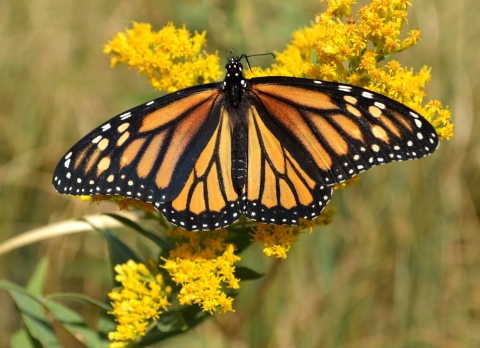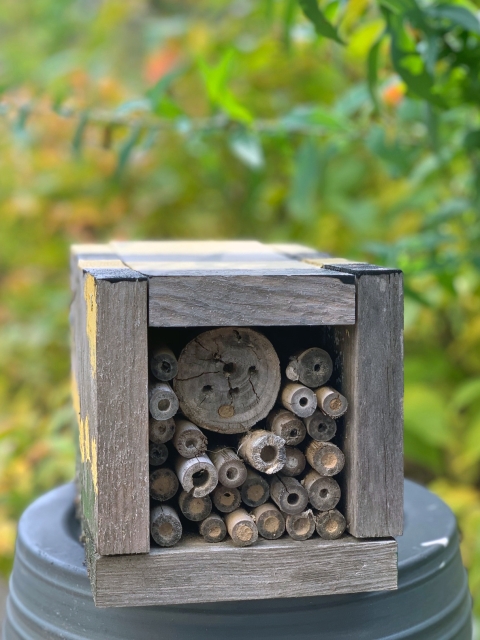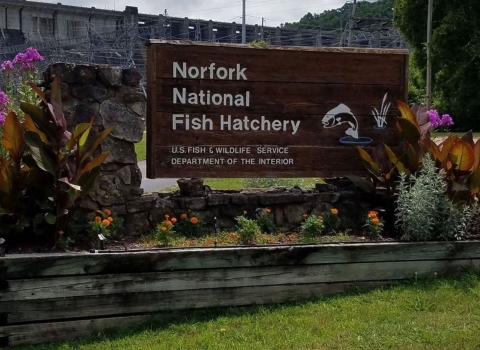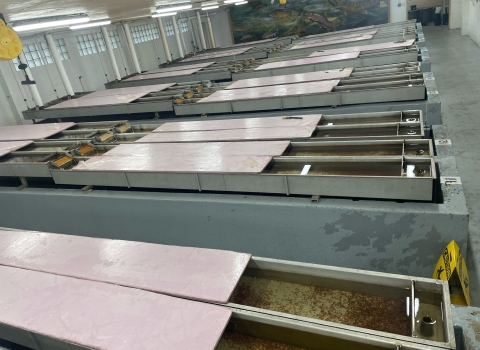You don't have to be a pollinator expert to save butterflies and bees. We at the U.S. Fish and Wildlife Service are continually learning about pollinators. Here are some of the basics and how you can get involved!
Wild bees are our primary pollinators
Pollinators provide more than $20 billion in direct services to agricultural industry. Approximately 84 percent of global crops have increased yields from wild bee and other insect pollination. Pollinators provide essential interactions with other plants and animals, like songbirds, trees, frogs and prairie grasses. With about 4,000 bee species in the United States, that adds up to an enormous amount of pollinating.
Honey bees are the celebrities in the bee world. Originally imported from Europe around 1622, honey bees are raised and managed. Honey bees are large and now commonly found in a hive box in backyards. They are also transported in large quantities across the country as a useful tool for farmers to pollinate crops like apples and almonds. If your field needs pollinating, you can place a beehive in the middle and let the bees go to work.
Almost all the rest of our bees are wild. Wild bees are shy and most lead solitary lives. They’re like the backstage crew for a music concert - you don’t realize it, but they’re actually running the show. Everyone’s listening to the musicians, but without the crew the event is silent.
Wild bees come in all shapes, sizes and colors, and so do flowers. They have coevolved together, creating a finely tuned relationship between particular plants and their special pollinators. This is how they can pollinate a diverse amount of plants. In contrast, honey bees are all the same, which limits their pollinating function. Some of the crops wild bees pollinate include squash, watermelon, tomatoes, blueberries, sweet peppers, raspberries and many more. Think what our kitchen tables would look like losing these foods.
Wings of colors
Butterflies and moths are another valuable pollinator group in our world - from grasslands to jungles. These fluttering creatures are highly sensitive indicators of the environment’s health, in addition to playing a crucial role in pollinating our food and flowers. They also come in a variety of colors that add beauty to our landscape.
This diverse group of insects comprises of more than 250,000 species. The monarch butterfly is our spokesperson, not only for insects, but for all pollinators throughout North America. With the monarch’s charisma and popularity, people are connecting to nature. This iconic pollinator is educating us on their importance. Its fascinating life cycle is used to educate about evolution and the natural world. The monarch migration is a phenomenon that inspires hope and connects to some cultural beliefs and traditions.
It is known that areas rich in butterflies and moths are rich in other invertebrates. These collectively provide a wide range of benefits including water quality, soil health and pest control.
The overlooked pollinators
These pollinators include birds, bats, beetles, ants, flies and mosquitoes. It is a very large group of unforgettable pollinators. They may not be as efficient as bees, but they still provide important services.
For instance, consider the lesser long-nosed bat, a once-endangered species removed from the list of endangered species in 2018. The nectar-feeding bat is economically valuable to tequila producers for its pollinating services. The producers, particularly in Mexico, who rely on and cultivate agaves, are increasingly integrating harvest and cultivation practices in recognition that agaves rely on bats for pollination and are even marketing “bat friendly tequila.”
If you love chocolate, then you love flies. They are the main pollinators for the cocoa tree to produce its fruit. Flies are also second in importance to bees as pollinating insects. They have lower energy requirements than bees which leads them to bask in flowers longer, ultimately picking up more pollen. Flies remain active into late fall, are the first to emerge in spring with cooler temperatures and occur almost everywhere, from deserts and forests, to wetlands and the arctic.
Beetles were among the first insects to visit flowers and they remain essential pollinators today. Research states they are responsible for pollinating 88 percent of the 240,000 flowering plants in the world. Your house and garden probably would not exist if not for beetles.
Where are they going?
Research is ongoing, but the prevailing theory among scientists is that the decline is related to complex interactions among stressors:
- Loss of habitat
- Intense agricultural practices
- Pesticide and insecticide exposure
- Predators
- Disease
- Climate change
We know pollinator populations are changing. We are still in the process of researching them, but because they are often small and solitary, they are difficult to study. Since we never really knew how many species were out there to begin with, it’s hard to say how much trouble they are in.
You can help!
We understand the desire to rake your leaves and cut dying flowers in the fall. Crunchy brown leaves, seed heads and stems are not as appealing as the manicured lawn and bright flowers that dominate summer. However, leaves and other lawn debris are beneficial to overwintering pollinators.
Plenty of pollinators overwinter in our yards, gardens and fields, using plants and debris that are left behind. In fall, leave some areas of your yard un-raked and plant stems standing. Here’s why:
- Butterflies and moths hibernate under bark and dried leaves and in seed pods. Caterpillars will roll up in leaves, overwinter as cocoons and chrysalises or go underground;
- Bees may hide in hollow stems or grasses, burrow into the ground or make use of man-made insect hotels;
- Flies tend to hibernate as adults in soil, or find shelter in plants and under plant debris;
- Beetles rely on cover under rocks, in hollow logs or beneath leaves; and
- Birds and bats either migrate to nectar blooming flowers or live in warmer climates where flowers bloom year-round.
Don’t stop there!
Simple actions can make a difference. Since pollinators depend on blooming plants, consider planting habitat in a pot, a backyard or a field. Most pollinators are active from early spring to late fall, so have plants that bloom throughout your growing season. Leave patches of bare ground and brush piles for overwintering and nesting. Scatter native seeds during the winter; most need cold temperatures to grow in the spring. Use nature-friendly products or reduce the amount of chemical use on your yard or farm. There are many organizations that will certify and provide a sign to post in your pollinator habitat. Tell a friend and neighbor what you do to help pollinators.The more we learn about the important tasks of pollinators, the more we become aware of how important every tiny bee, butterfly and beetle is to nature and to us.











